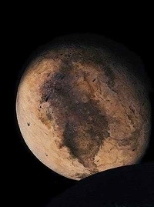NASA has authorized the New Horizons Pluto-Kuiper Belt mission to go forward with spacecraft and ground system construction.
The mission will be the first to Pluto and the Kuiper Belt. Richard P. Binzel, professor of earth, atmospheric and planetary sciences, is co-investigator.
The New Horizons spacecraft is scheduled to launch in January 2006, swing past Jupiter for a gravity boost and scientific studies in 2007, and reach Pluto and its moon, Charon, as early as summer 2015.
"We have been working toward a Pluto mission for more than a decade and it feels very good to finally have the green light. Our mission planning is very far along and we are moving forward full speed," said Binzel.
After a six-month encounter with Pluto-Charon--during which New Horizons will characterize Pluto's and Charon's global geology and geomorphology, map their surface compositions and temperatures, and examine Pluto's complex atmosphere--the spacecraft will head deeper into the Kuiper Belt to study one or more of the icy mini-worlds in that vast region, at least a billion miles beyond Neptune's orbit.
Pluto was discovered in 1930, and the first Kuiper Belt Object was sighted in 1992. Since then, almost 1,000 more objects have been detected. Neither Pluto nor Kuiper Belt Objects have ever been explored by spacecraft.
New Horizons is led by the Southwest Research Institute in Boulder, Colo., and the Johns Hopkins University Applied Physics Laboratory (APL).
NASA selected New Horizons on November 29, 2001, after a competition between industry-university teams who responded to a NASA request for proposals. Since selection, the New Horizons mission and science team has been working to complete the design of the spacecraft, instruments, ground system, and mission profile and detailed planning for the construction phase of the project.
Upcoming project milestones for New Horizons include the selection of a launch vehicle this summer, the start of spacecraft assembly in spring 2004 and the beginning of integrated spacecraft and instrument testing in May 2004.
In addition to MIT, APL and SwRI, the New Horizons team includes Stanford University, Ball Aerospace Corp., NASA Goddard Space Flight Center and the Jet Propulsion Laboratory. The mission science team includes expertise from the above institutions, as well as Lowell Observatory, NASA Ames Research Center, Washington University (St. Louis), George Mason University, Johns Hopkins University and the University of Colorado.
More information on New Horizons can be found at http://pluto.jhuapl.edu. More information on Pluto-Charon and the Kuiper Belt can be found at http://www.plutoportal.net.
A version of this article appeared in MIT Tech Talk on April 16, 2003.






